Last Updated on January 18, 2024 by Greg Gillson
Did you see a brightly-colored red bird, orange bird, or yellow bird in South Carolina and wonder what is was?
This page is for you!
This article shows you photos and identification of some of the most common birds in South Carolina based on color.
The list of birds found in South Carolina includes over 450 species. So, I can’t show you all of them. I’m going to assume that you saw a common bird of this color, but you certainly could have seen something less common, or even rare!
Shape (including the shape of the bill) and size are often more helpful in starting to identify a bird than the color. In fact, most birds in North American can be easily identified with a black-and-white photo!
Many birds are multi-colored, so that it may be hard to pick out a dominant color. Males and females may be colored quite differently. And some color patterns are similar among otherwise dissimilar species.
Nevertheless, I’m going to try to pick out some of the birds that you are most likely to see in backyards or towns. And I’ll show a few others that I get asked about a lot.
The birds with a noticeable amount of red on them in South Carolina covered in this article are:
- House Finch
- Northern Cardinal
- American Robin
- Ruby-throated Hummingbird
- Sumer Tanager
The birds with a noticeable amount of orange on them in South Carolina covered in this article are:
- Eastern Towhee
- Brown Thrasher
- Red-shouldered Hawk
- Barn Swallow
- American Kestrel
- Ruddy Duck
- Orchard Oriole
- American Redstart
- Cooper’s Hawk
The birds with a noticeable amount of yellow on them, including lots of yellow and black birds, in South Carolina covered in this article are:
- Yellow-rumped Warbler
- Pine Warbler
- American Goldfinch
- Northern Flicker
- Great Crested Flycatcher
- Northern Parula
- Common Yellowthroat
- Cedar Waxwing
- Yellow-throated Warbler
- Palm Warbler
- Eastern Meadowlark
- Prothontary Warbler
Red birds of South Carolina
Birds get the red, orange, and yellow in their feathers from carotenoids in the fruit, seeds, and plants they eat (source).
These carotenoid colors combine with melanin to form an infinite range of red feathers–pink, rusty, scarlet, violet, red-orange.
The following are red birds that you are most likely to see in South Carolina.
House Finch
When people ask about a bird with a red head at their feeder, it is usually this bird.
 |
| Male House Finch. Greg Gillson. |
Males of this dusty brown striped finch have red limited to the head (specifically the forehead and eyebrow), breast (chest), and rump. The red coloration tends toward orangish, and may rarely be yellowish.
Females are streaked, similar to the males but without red. They lack any strong pattern on the face and head.
Note the small round head and curved upper ridge on the bill.
Some people call these red-headed sparrows. Sparrows and finches are similar, but in general, male finches are brighter than the females and tend to hang out more in trees. Sparrow genders are usually quite similar in coloration and tend to feed mostly on the ground.
These birds are common in residential areas, especially at bird feeders. In the West more widespread in arid regions near water.
House Finches are year-round residents throughout South Carolina.
Northern Cardinal
These are one of the most common backyard birds in the eastern United States. Their bright red color and unique head profile makes them instantly identifiable to most people–whether they are bird watchers or not!
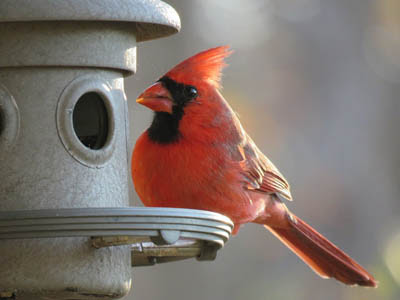 |
| Northern Cardinal. GeorgeB2 from Pixabay. |
Males of these large seed eaters are bright red with a black face and red crest.
Females replace most of the red with brown, The bill is large and orange.
These birds are found in woodlands, stream edges, residential areas.
Northern Cardinals are year-round residents throughout South Carolina.
American Robin
These are familiar lawn birds with red breasts.
 |
| American Robin. Greg Gillson. |
Male American Robins are brownish-gray above with a brick red breast. Females are paler orange below and paler gray above.
They are widespread in open country with scattered deciduous trees, residential areas.
American Robins are year-round residents throughout South Carolina.
Ruby-throated Hummingbird
These red-throated birds are the only hummingbird nesting in the eastern United States.
Males are dark green above and on the belly. They have a white upper chest. The throat is ruby-red.
Females are green above, white below, including white throat.
These birds are found in woodland edges, residential yards. Readily come to hummingbird feeders.
Ruby-throated Hummingbirds are summer residents throughout South Carolina.

Summer Tanager
These bright red birds are found toward the tops of tall trees in the southern United States.

Males are rose red with fairly heavy bill.
Females are yellowish or mustard-colored, some with a faint reddish wash.
In the East these birds are found in pine-oak woodlands. In the West they prefer tall cottonwood trees.
Summer Tanagers are summer residents throughout South Carolina.
Orange birds of South Carolina
True orange-colored birds are not that common. Many birds that I have here are paler rusty.
The common pattern is an orange body and black or brown wings and tail. Another common pattern is for the orange to be restricted to the under parts.
The following are orange birds that you are most likely to see in South Carolina.
Eastern Towhee
These birds with rusty-orange sides like to hide in dense bushes.
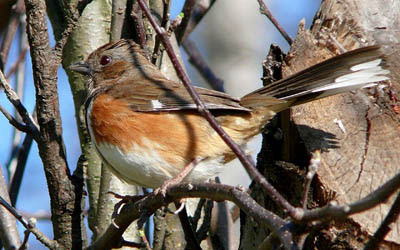 |
| Female Eastern Towhee. Skeeze. Pixabay. |
Males are black above with white wing patch, white tail corners. The sides are rusty. The belly white. Eyes variable: brown, red, orange, white, tending toward whiter southward.
Females are similar, but upper parts brown.
These birds are found in forest understory, dense brush, backyard hedges. Come to feeders.
Eastern Towhees are year-round residents throughout South Carolina.
Brown Thrasher
These are rather large rusty-orange songbirds.
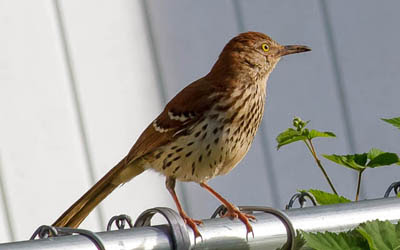 |
| Brown Thrasher. Linda Jones CC0. |
The upper parts of these birds is colored rusty-brown to orange. They show two white wing bars. Under parts are buff with heavy reddish-brown streaking.
These birds live in woodland edges and mature backyard landscaping.
Brown Thrashers are year-round residents throughout South Carolina.
Red-shouldered Hawk
Okay, the shoulders are reddish. But the rusty-orange breast and wing linings are barred red too.
 |
| Red-shouldered Hawk. Greg Gillson. |
The upper parts are barred black and white. The tail is banded black and white. In adults the breast is barred orange.
Immature birds are streaked with brown on the breast.
These birds like woodland edges, residential edges, riparian groves.
Red-shouldered Hawks are year-round residents throughout South Carolina.
Barn Swallow
These orange-bellied birds are a familiar sight across North America in summer.
 |
| Barn Swallow. Greg Gillson. |
These birds are purple-blue above with orange under parts and long forked tails. The color of the underparts in winter or on females are often cinnamon or buff-colored, but breeding males can be brighter orange-red.
These birds swoop low over fields and wetlands at lower elevations. They may build their mud nests in rafters on porches, garages, or other out-buildings.
Barn Swallows are summer residents throughout South Carolina.
American Kestrel
These are the familiar small rusty-orange falcons sitting on power lines on the edge of the highway, or hunting and hovering over the median strip.
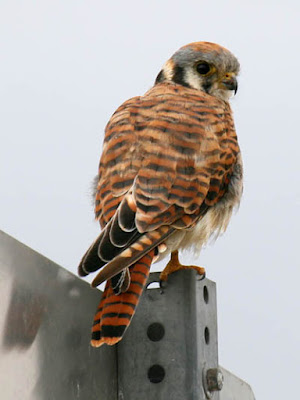 |
| Female American Kestrel. Greg Gillson. |
Females are rusty orange barred with black on their back wings and tail. The under parts are buff with black spots. The head shows two facial stripes.
Males have blue-gray backs and rufous tail is unmarked except for black tail band.
These birds are found in open country, farms, pastures with perches.
American Kestrels are year-round residents throughout South Carolina.
Ruddy Duck
These small ducks are dark rusty-orange in spring.
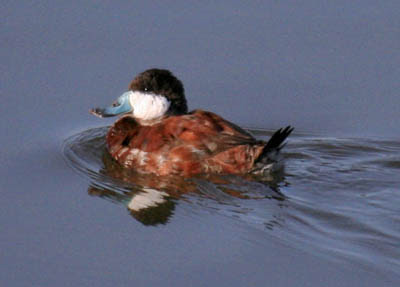 |
| Ruddy Duck. Greg Gillson. |
Males in breeding plumage (late winter and spring) are rusty, with a white face, and a blue bill. The long tail is often held sticking up. In winter they are brown, with white face, and dark bill.
Females all year are like winter males. Brown body, dark cap, dark line through eye of pale face. Dark bill.
These birds prefer weedy ponds to breed, but in winter may be found in deeper ponds in city parks.
Ruddy Ducks are winter visitors in the coastal plain of South Carolina, spring and fall migrants throughout.
Orchard Oriole
Males of these orioles are darker rustier-orange than most other orioles in the United States.
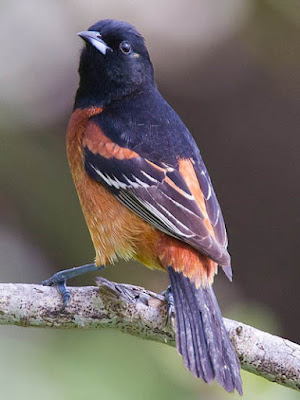 |
| Orchard Oriole. Dan Pancamo. Flikr. CC BY-SA 2.0 |
Males have a black hood and back, black wings and tail. The under parts are rusty-orange or even chestnut-brown.
Females are greenish above, lemon yellow below. They have 2 thin white wing bars. The bill is thinner than many other orioles.
They are found in orchards and residential shade trees.
Orchard Orioles are summer residents throughout South Carolina.
American Redstart
In flight these small warblers flash orange or yellow in the wing and base of the tail.
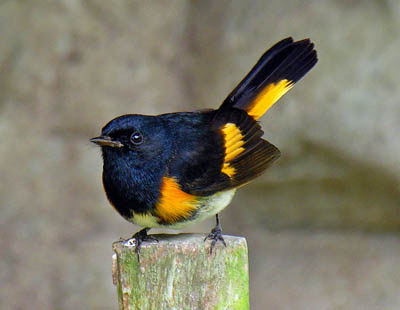 |
| American Redstart. Dennis Jarvis. Flikr. CC BY-SA 2.0 |
Males are black above, white on the belly. They have bright orange patches on side of breast, wings, and base of the tail.
Females are grayer, especially on the head. The orange of males is replaced by yellow on the females.
These birds are found in regenerating woods after a clear cut, and willow tangles along streams.
American Redstarts are rare summer residents in northern South Carolina, spring and fall migrants throughout.
Cooper’s Hawk
These crow-sized hawks with reddish orange bars on the under parts may show up in fall or winter to hunt birds at your feeder. Oh no!
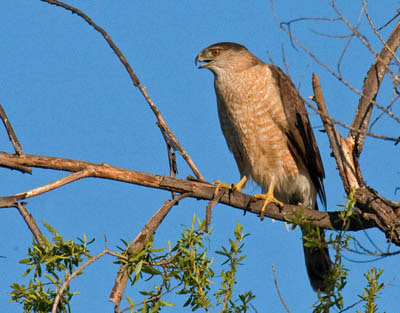 |
| Cooper’s Hawk. Greg Gillson. |
Adults with long gray and black banded tail. Dark gray above and cap on head. Under parts barred with rusty orange.
Immatures similar, brownish, streaked with brown on under parts.
Found in forests and woodlands, residential shade trees.
Cooper’s Hawks are year-round residents throughout South Carolina.
Yellow birds of South Carolina
Yellow is a common bird color! Often it is mixed with black and white plumage in birds.
Many birds with darker upper parts have yellow breast or belly.
The following are yellow birds you are most likely to see in South Carolina.
Yellow-rumped Warbler
These are abundant warblers across North America. Affectionately called “butter butts” by many birders, because of their bright yellow rumps that flash in flight.
 |
| Yellow-rumped (Myrtle) Warbler. Greg Gillson. |
Western form (Audubon’s) with bright yellow throat and yellow rump. Large white wing patch.
Northern and Eastern form (Myrtle) with white throat, yellow rump, and two white wing bars.
Winter birds are dull gray brown, with bright yellow rump. Throat may be cream colored or white. Often difficult to tell the two forms apart in winter.
 |
| Winter Yellow-rumped Warbler. Greg Gillson. |
Breed in mountain or boreal conifers. Widespread in migration. Winter in low river bottoms, open weedy deciduous areas. Rarely come to feeders in winter.
Yellow-rumped Warblers are winter visitors throughout South Carolina.
Pine Warbler
This yellow and gray bird is one of the few warblers to visit feeders–and the only one to eat seeds!
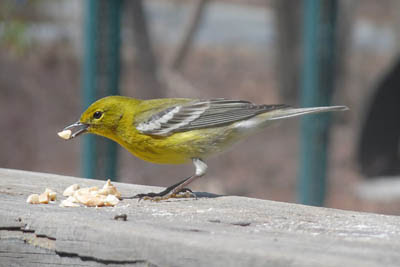 |
| Pine Warbler. Nikolaus Schultz. Pixabay. |
These birds are yellow-green on head, back, and breast. Wings blue-gray with wide white wing bars. Yellow split eye ring.
Strongly associated with pine forests. Usually high in tree tops.
Pine Warblers are year-round residents throughout South Carolina.
American Goldfinch
These small little birds are bright yellow and black.
 |
| American Goldfinch. Greg Gillson. |
Males are bright lemon yellow with black and white wings and tail, black cap. White under tail coverts. Pink bill.
Females are duller yellow below and brownish above. Lack black cap.
Winter birds are pale brown or gray, a touch of yellow on the throat of males.
These are birds of open country, fields with saplings, clear cuts, residential areas. They avoid dense forests, mountains, deserts. They visit feeders.
American Goldfinches are year-round residents in interior South Carolina, winter visitors only on the coastal slope.
Northern Flicker
These woodpeckers spend much time eating ants on the ground.
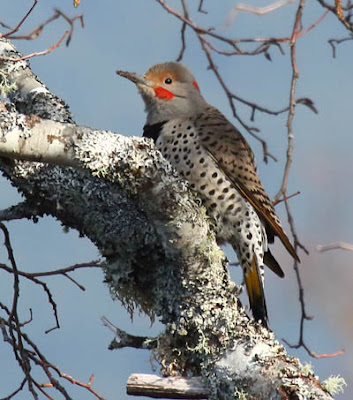 |
| Northern Flicker. Greg Gillson. |
These birds are larger than robins with brown and black barred upper parts. The underparts are pink with round black spots. There is a black crescent across the chest. When they fly away from you they reveal a large white rump.
Western birds have salmon-red under wings and under tail. Those in the East are colored yellow. The male face differs between the two populations–black whisker on the eastern birds, red whisker on western birds. Intergrades from overlap on Great Plains common. These may show male facial characteristics of both populations, or yellow-orange flight feathers.
These birds live in open woods with bare ground for foraging, residential yards.
Northern Flickers are year-round residents throughout South Carolina.
Great Crested Flycatcher
These flycatchers have long tails and big heads with big bill and bright yellow belly.
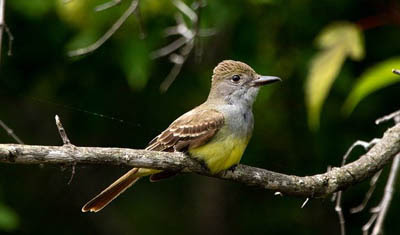 |
| Great Crested Flycatcher. Simard Francois. Pixabay. |
These birds are gray on the face and breast, brownish on rest of upper parts. Bright lemon yellow belly. The under side of the tail and some feathers of the wing are cinnamon colored.
These birds stay in the canopy of open woods.
Great Crested Flycatchers are summer residents throughout South Carolina.
Northern Parula
This is a handsome blue and yellow warbler.

Males are blue on the hood and shoulders. Back green. Yellow throat and breast with a dark red spot mid-chest. Broken white eye ring. Two wide white wing bars.
Females are similar, but paler.
They are found along streams and in swampy forests with willows, maples, birches, hemlocks and other trees.
Northern Parulas are summer residents throughout South Carolina.
Common Yellowthroat
These buttery yellow birds are abundant in the marsh vegetation.
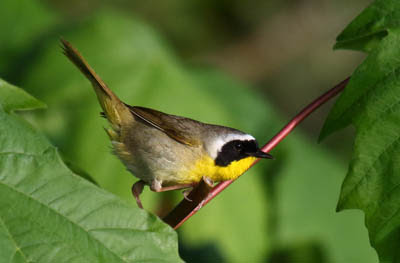 |
| Male Common Yellowthroat. Greg Gillson. |
These skulkers have bright yellow throats and yellow undertail coverts. Males have a black domino mask edged broadly in white, which females lack. Upperparts are dull olive-green.
Immature males in fall show a shadowed black mask.
Found in damp situations and heavy deciduous brambles following clear cuts.
Common Yellowthroats are year-round residents throughout most of South Carolina.
Cedar Waxwing
These crested birds with yellow band on the end of the tail are often found in flocks. They eat flying insects in summer, fruit and berries the rest of the year.
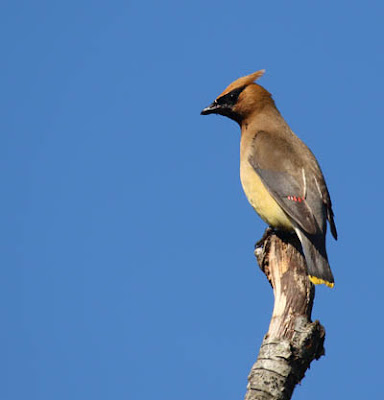 |
| Cedar Waxwing. Greg Gillson. |
These birds are fawn-brown above, with dark gray wings and tail. They have a black mask and wispy crest. The belly is yellow. The wings have waxy red drops on the end of the tertials. The end of the tail has a brilliant yellow tail band.
They are found in open habitats with berries, including juniper woodlands and towns in winter.
Cedar Waxwings are winter residents throughout South Carolina.
Yellow-throated Warbler
These birds with the bright yellow throats creep along the branches high in trees.
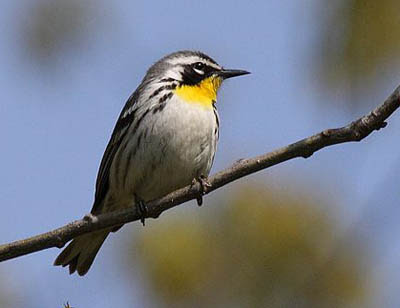 |
| Yellow-throated Warbler. Dominic Sherony. CC 2.0 |
These are rather gray warblers with bright yellow throat and upper breast. Black crown and face mask with white patch behind. White eyebrow. Two broad white wing bars. Black streaks on white breast and belly.
They like pine-oak woodlands, sycamores, cypress.
Yellow-throated Warblers are summer residents throughout South Carolina, year-round residents on the coastal slope.
Palm Warbler
This rather drab bird has bright yellow under tail coverts. It tends to spend much time on the ground in disturbed soils. It constantly bobs its tail up and down.
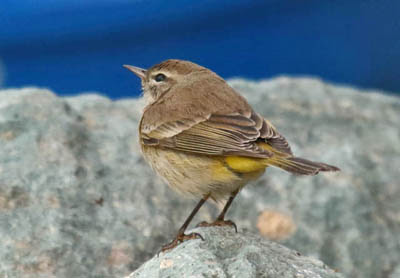 |
| Winter Palm Warbler. Greg Gillson. |
Breeding birds are rather gray with yellow throat, vent and under tail coverts. White eyebrow stripe. Chestnut cap. Eastern birds tend to be more yellowish on the breast.
In winter birds are very pale, but with yellow under tail.
They nest in bogs within boreal forests. They like similar habitat at other times of year: open land with isolated scrubby trees or bushes, including coastal scrub.
Palm Warblers are winter visitors on the coastal slope of South Carolina, spring and fall migrants throughout.
Eastern Meadowlark
These pale brown birds with the brilliant yellow breasts are home on the ground in prairies. They sing from perches on isolated trees, power poles, fence posts.
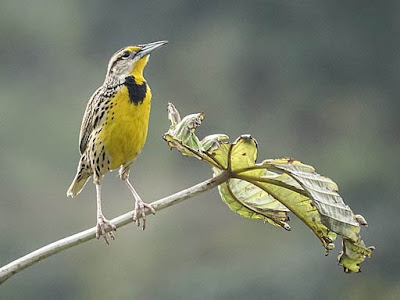 |
|
Eastern Meadowlark
Photo by Mike’s Birds from Riverside, CA, US [CC BY-SA 2.0]
|
The upper parts are streaked black, white, brown, so they blend into the dried grass where they live. The under parts are bright yellow with a black necklace across the chest. Very similar to Western Meadowlark, best told apart by spring song.
These birds live in prairies and extensive pasture lands.
Eastern Meadowlarks are year-round residents throughout South Carolina.
Prothonotary Warbler
These bright yellow birds are found in southeastern swamps.
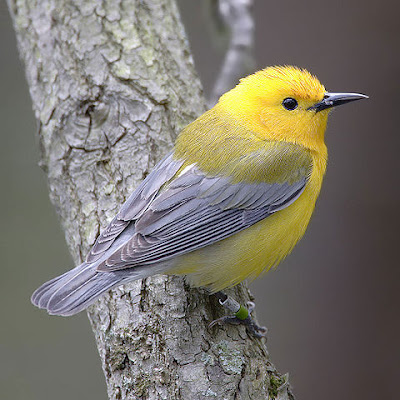 |
| Prothonotary Warbler. MDF. CC BY-SA 3.0 |
These birds are bright yellow with green back, gray wings and tail. The beady black eye stands out in the middle of the yellow face.
These birds stay low in the understory in swamps and bottomland forests, near or over water.
Prothonotary Warblers are summer residents throughout most of South Carolina.
Wrapping Up
South Carolina boasts a kaleidoscope of colorful birds, adding vibrancy to its diverse landscapes from coastal marshes to mountain forests. Here are some more of the most captivating feathered jewels you might encounter:
Summer Residents:
- Baltimore Oriole: These fiery orange and black beauties grace trees with their hanging nests and melodic whistles. Look for them in open woodlands, parks, and along rivers.
- Eastern Bluebird: With their bright robin’s egg blue chests and rusty red breasts, these charming songbirds add a touch of elegance to backyards and open fields.
- Summer Tanager: Males burst with color, sporting a scarlet body, black wings with white wing bars, and a turquoise head. They frequent wooded areas and riparian zones.
- Painted Bunting: A splash of tropical paradise in the Carolinas, males showcase vibrantly contrasting colors—blue head, red breast, green back, and yellow belly. Find them in grasslands, shrublands, and open woodlands.
Year-Round Beauties:
- Northern Cardinal: These iconic songbirds bring a splash of red to gardens and woodlands with their scarlet bodies, black masks, and crested heads. Both males and females are colorful, though females are more muted.
- Indigo Bunting: Males shimmer with a brilliant blue plumage, especially in sunlight. Look for them in fields, gardens, and shrublands. Females wear a more subdued brown but are still quite charming.
- Red-bellied Woodpecker: Their bold plumage features a black back, white underparts, and a crimson crown and nape. Listen for their drumming on trees and watch them forage for insects in woodlands and parks.
Frequently Asked Questions
What is a large reddish brown bird in South Carolina?
The Brown Thrasher, a robust and energetic songbird, is a familiar sight and sound in the diverse landscapes of South Carolina. Here are some captivating facts about this feathered resident:
A Master Mimic: Renowned for its impressive vocal repertoire, the Brown Thrasher can mimic the songs and calls of over 1,000 other bird species! From mockingbirds to cardinals, woodpeckers to owls, you might encounter a surprise melody coming from its hidden perch.
Fierce Defender: Don’t underestimate this brown bird! Brown Thrashers are surprisingly aggressive, fiercely defending their nests and territories. They’ve been known to attack larger birds and even humans who approach too close. So, admire them from a respectful distance!
Omnivorous Delight: They enjoy a varied menu, feasting on insects, worms, beetles, berries, and even small fruits. You might see them foraging on the ground, hopping through low vegetation, or gleaning insects from tree branches with their strong, curved bills.
Where can I find orange orioles in South Carolina?
The Baltimore Oriole is definitely seen more often in South Carolina now than in the past! This shift in their wintering range is a relatively recent trend, observed over the past few decades. Here’s a breakdown of the situation:
Historically:
- Baltimore Orioles used to breed in the north during summer and migrate south to Central America and northern South America for winter.
- South Carolina primarily saw them during spring and fall migration, with only a few individuals lingering into winter.
Recent Changes:
- Warmer winters due to climate change have allowed Orioles to survive farther north during the winter months.
- Increased availability of food sources like backyard feeders and fruit-bearing trees has attracted them to stay in South Carolina.
- Data from the South Carolina Department of Natural Resources (SCDNR) and the Great Backyard Bird Count show a significant rise in Baltimore Oriole sightings in the state during winter.
Why is the Prothonotary Warbler so named?
There are two main schools of thought regarding the origin of the Prothonotary Warbler’s name:
1. Papal Clerks Association:
This is the more traditional and widely accepted explanation. It suggests the bird’s bright yellow plumage resembles the golden robes worn by high-ranking officials in the Catholic Church known as protonotaries apostolic. These officials traditionally wrote and authenticated papal documents. This connection was likely made by early European settlers in North America who observed the similarities.
2. Byzantine Origin Theory:
A more recent theory proposed by Rick Wright challenges the traditional explanation. Wright argues that the name “Protonotary” might have originated from a misunderstanding of Byzantine court terminology. He postulates that early explorers might have encountered a document mentioning a “protonotarios,” a Byzantine court official who wore golden-yellow robes. This pronunciation and meaning could have been misconstrued and later applied to the warbler.
Related Articles:
See photos and learn about the most common backyard birds in South Carolina, regardless of color.
See photos and learn what to feed winter birds in South Carolina.
Here’s a quick tutorial of how I would teach you to identify birds: 7 Steps to Identify Birds!
Birds with red heads in North America.
Yellow-and-black birds in North America.










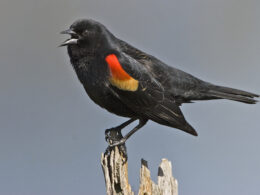
I have been seeing a small rounded body bird with a red breast and a black head and I am trying to figure out what it is. I live in Sumter, S.C.. Any ideas of what it could be?
I suspect Eastern Towhee. It is in the orange-breasted section and the bird looks paler gray, but males are blacker.
I have seen this bird as well, and it doesn't look like the photos I have seen of the eastern towhee as it has no white on them at all.
Well, I'm stumped! If it was spring or summer, there are orioles and others to consider. But in winter the choices are limited.